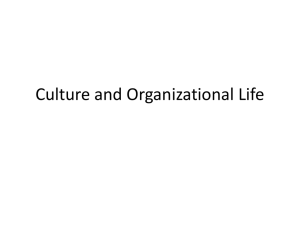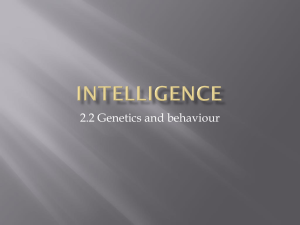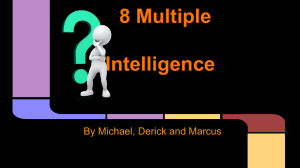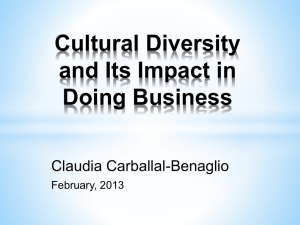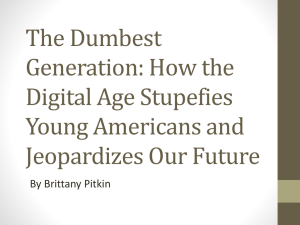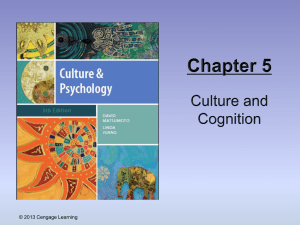Cultural Intelligence Matters
advertisement
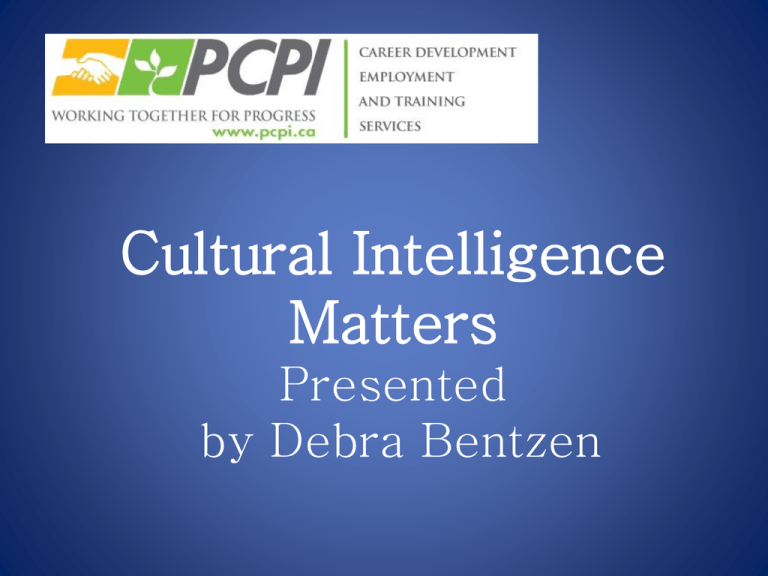
Cultural Intelligence Matters Presented by Debra Bentzen WHAT IS CULTURE? • It is the “lens” through which you view the world • It is central to what you see • How you make sense of what you see • How you express yourself Cultural Intelligence Defined • CI is your capability to grow personally through continuous learning • Good understanding of diverse cultural heritage, wisdom and values • Deal effectively with people from different cultural background and understanding CULTURAL DIFFERENCES ONE WAY- MANY PATHS • UNLESS YOU KNOW THE RULES OF OTHER CULTURES YOU CAN MAKE SERIOUS ERRORS OF JUDGEMENT RESULTING IN INSULTING YOUR COLLEAGUES, MANAGER AND VICE VERSA. COMMUNICATION STYLE • The Japanese or English may distrust Italians because they wave their hands about or Spaniards because they sound emotional • The French may appear offensive as they are direct and frequently use criticism • Germans may take the English too seriously and completely miss the humour or irony • No- one may know what the Japanese are thinking as they may say little or nothing at all. GREETINGS • In some countries, men and women are forbidden to touch hands.....in others public displays of affection are normal as is the practice of hand shaking. PERSONAL SPACE • In some countries it may seen there is no such thing as personal space! • When queuing in some countries; when they actual have line-ups, standing so close to the person in front that they can feel your breath on their neck is not considered an issue. • In other countries this would seem offensive. EYE CONTACT • In Asia direct eye contact can be interpreted as rude and disrespectful. • In North America it is an important way to show sincerity and trust VIEW OF TIME • In North America it is advisable to always be punctual. • In many Latin countries punctuality is not as important as arriving at all, whatever the time. GESTURES – THE OKAY SIGN • This has different meanings when used depending upon your location: • North America – to show approval • Japanese – to signal money • Brazil – it is a vulgar sign • France – means zero • Middle East - a rude sexual gesture Taboos • In some parts of the Middle East and the Far East, showing the sole of your shoe sends a rude message • In Thailand, it is rude to sit crosslegged • Flowers, a thoughtful gift through most of the world can get you into trouble: • Red Roses are reserved for one’s sweetheart in Eastern Europe • Chrysanthemums are strictly a funeral flower in France, Italy and Hungary. Three Levels – Cultural Intelligence • Visible – clothes, music, food, festivals, superficial but the one most known • Behaviour – non-verbal communication for example whether one gives eye contact or not. VALUES • The glue behind the decision making and behaviour modification. • It is abstract and usually unconscious but most often is the key to how individuals define themselves like the roots of a tree, deep and strong – influenced by family, geography and history elements. SELF ASSESSMENT OF YOUR CI Think about your cultural intelligence in each of the following areas 1- None of the description fits me 2- Only some of this fits me 3- Half of the description fits me 4- Most of the description fits me 5 –The statements describe me perfectly CI- ACTION 1.....2.....3.....4.....5 I modify my behaviour to make other more comfortable when I interact with people who are from different cultural backgrounds. I change the way I speak and act when I am in cross-cultural settings. I mimic others to make sure that I follow local conventions so that my speech patterns and body language are not offensive. CI - Knowledge 1....2.....3......4.....5 I generally understand other cultures and cultural values. I know about the basic ways in which cultures are similar and the ways they are different. CI - Strategy 1....2.....3......4......5 I plan carefully before I meet with someone who is from a different cultural background. After one of these experiences, I reflect carefully and try to make sense of the interaction. CI - Drive 1....2.....3......4....5 I am very interested in other cultures, and I enjoy meeting people who have different cultural backgrounds. I am confident that I can live in different cultures and I that I can adapt to different parts of the world. Interpreting your CI – Self Assessment ADD YOUR SCORES – can range from 4 – 20 4 – 7 - You see yourself as low in CI – personal development in this area could help 8 – 16 – You see yourself as moderate in CI –personal development would help you function more effectively. 17 – 20 – You see yourself as high in CI – keep building on your strengths. CONCEPTS RELATED TO CULTURAL INTELLIGENCE • C- culture is pervasive – Everyone, every organization, every region, and every country has a culture. • U – Understanding cultural beliefs, values, and perceptions of others is a key to success..AND vice versa • L – Learning diverse cultural heritage is rewarding, inspiring and empowering CONCEPTS • T – Teamwork in the increasingly global and diverse workplace is impossible without cultural intelligence • U – “Us” and “Them” cultural programming and divide can be eased through better understanding of “their” perceptions • R – Rapport starts with understanding of where the other people are coming from and acceptance of their point of view and style. CONCEPTS • E – Exploiting cultural diversity is a key to unlimited innovation and growth CULTURAL INTELLIGENCE – IT’S IN OUR BEST INTEREST • In the global economy today, cultural intelligence is a necessary tool for everyone from the manager to the employee, customer, partner, competitor, government and other business players. • CI may enhance the likelihood of innovation success in culturally diverse teams/organizations • CI facilitates the reconciliation of differences and conflicts, and enhances the probability of synergistic solutions embracing the ideas and interests of various parties CULTURAL INTELLIGENCE • Is about gaining increased knowledge and mindfulness of the values associated with different cultures, and how these values impact workplace behaviour. • It enables people and companies to work with groups whose cultural background is different from their own. • It requires the knowledge of these different cultures. • It requires the ability to adapt behaviour to these differences as needed. CI RESEARCH A diverse workplace outperforms a homogenous organization with: 1 – Higher productivity 2 – Engagement and retention 3 – Performance improves when employers and employees become better aligned with each other’s cultures and values HOW CAN WE IMPROVE OUR CI? • Appropriate Cultural Training • Organizations can promote by offering incentives to adapt behaviour • Cultural Competency assessments can be taken to promote a self –awareness/mindfulness of CI • Recruitment/Retention Strategy reviews within organizations Managing Cross- Cultural Differences • Culture is often the root of COMMUNICATION CHALLENGES. • Becoming more aware of cultural differences as well as exploring cultural similarities can help you communicate with others more effectively. • Next time you find yourself in a confusing situation, ASK YOURSELF HOW CULTURE MAY BE SHAPING YOUR OWN REACTIONS AND TRY TO SEE THE WORLD FROM THE OTHER’S POINT OF VIEW. CQ is Critical • CQ cannot be manufactured in a short period of time. • It takes WORK, MOTIVATION and CONSTANT PRACTICE • It is not unusual for employees to have excellent technical skills but often lack interpersonal skills – an ability to handle their own emotions and accept feedback from others A question to ponder...... Which of your competencies would you rank higher – your “technical” expertise in a specific area or your CQ? Why? BUILDING YOUR CQ This is no easy task- we need to nurture and practice those cognitive and behaviourial skills that allow us to adapt and excel in any or all environments Retooling and re-educating ourselves is an ongoing process that can be humbling and uncomfortable at times WE CAN DEVELOP THESE SKILLS • Understanding My Cultural Identity – understanding how we think about ourselves as well as the people and ways of life with which we identify • Checking Cultural Lenses – Recognizing the ways in which cultural backgrounds differ and how they influence thinking, behaviour and assumptions. • Global Consciousness – Moving across boundaries and seeing the world from multiple perspectives • Shifting Perspectives – Putting ourselves in others’ shoes and cultures • Intercultural Communication – Exchanging ideas and feelings and creating meanings with people from diverse cultural backgrounds • Managing Cross-Cultural Conflict – Dealing with Conflict among people from differing cultural backgrounds in an effective and constructive manner • Multicultural Teaming – Working with others from diverse cultural backgrounds to accomplish certain tasks. • Dealing with Bias – Recognizing bias in ourselves and others and responding to it effectively • Understanding the Dynamics of Power – Grasping how power and culture inter-relate and the effect of power on how we see the world and relate to others. Where am I now? • • • • • Rank yourself on the following CQ skills: M – need much improvement S – need some improvement L – need little improvement 1. -------- Understanding my Cultural Identity • 2----------Checking Cultural Lenses • 3----------Global Consciousness • 4--------Shifting Perspectives • 5--------Intercultural Communication • 6--------Managing Cross-Cultural Conflict • 7--------Multicultural Teaming • 8--------Managing Bias • 9--------Understanding the Dynamics of Power Cultural Intelligence Myths • CQ is only important for some jobs and some people – • Developing CQ is all about changing people ‘s awareness- only the first step • CQ training aims to change people’s values. • There is a simple formula or strategy for developing CQ – the challenge is not just to learn the skills but to regularly use the skills effectively LAST BUT NOT LEAST • CQ comes naturally to people with good intentions – if your heart is in the right place it just happens??? - Understanding and respecting cultural diversity is not just something that happens because you see yourself as a person of character and you mean well. BUILDING CQ • This involves three key actionoriented strategies: 1. Assessing CQ www.culturalq.com/selfassess.html Respond to the 20 items and then reflect. 2 – Taking Responsibility for Learning • This means taking advantage of learning opportunities both at work and elsewhere. • This can include experiential, collaborative, and e-learning • Since culture is fluid and changes from moment to moment part of the challenge of developing and applying CQ is adapting, re-evaluating and tailoring how we respond to specific situations 3 – Optimizing the Learning • Understanding the value of what we are learning – what are the bottom line benefits for the competencies. Research supports that both CQ and technical skills are essential • Actively participate in the learning process – this means a continuous cycle of action and reflection – building our knowledge in the real world • Apply what we learn in our day to day interactions – practice practice and ask for feedback • Develop an action plan • Specific skill you want to work on • Your strategy for developing this skill • What you will do and when • Possible obstacles Action plan • Necessary Resources • Means of assessing your resources Learning Opportunities • Experiential Learning – Learning by Doing • Collaborative Learning – learning by working with others • Academic Learning – Learning by taking courses, and training that is offered in the classroom and online • E-Learning – learning via computer such as surfing on the web Learning Opportunities • Incidental Learning – learning by taking advantage of every opportunity that presents itself including those that are unexpected and unplanned. Summary Cultural Diversity is changing realities The meaning of Culture The meaning of Cultural Intelligence Why Cultural Intelligence is important To identify the nine skills of CQ Three Strategies for developing cultural intelligence. THANK YOU YOU CAN VISIT US AT
